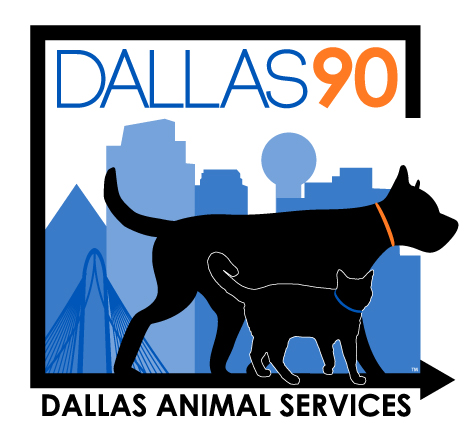OUR HOURS | 1818 North Westmoreland Road, Dallas TX 75212
Wildlife
Urban Wildlife in Dallas
The city of Dallas is home to a variety of native wildlife including coyotes, raccoons, possums, and more! It is up to all of us to protect and coexist with wildlife. Dallas does not own or have control of any of the wild animals found within its boundaries, nor is the city of Dallas responsible for the actions or damage caused by wildlife. DAS responds to situations where public safety is being jeopardized but, in general, these animals are a common and important part of our ecosystem.

Let Wildlife Be Wild!
Please DO NOT feed, touch, or attempt to catch any wildlife you find. Our city is their home as well and we should view them from a safe distance and avoid interactions that could cause them to be more social or friendly with humans.
Our Approach to Wildlife
While DAS does respond to service requests regarding sick or injured wildlife and those that may pose a threat to public safety, we DO NOT trap apparently healthy wildlife that does not pose a threat. We also work to educate the public and provide wildlife resources to keep YOU safe and preserve the wildlife and their habitats.
When to Call DAS About Wildlife
- We DO NOT dispatch officers to service traps or remove/relocate wildlife.
- Please DO NOT set traps for wildlife, or any species, in extreme temperatures.
Dangerous Wildlife
If you are concerned about a potentially dangerous animal in the city of Dallas, please call 311 or make a service request online immediately. DO NOT interact with the animal in any way. Get yourself and your pets inside to safety.
Sick or Injured Wildlife
If you have found wildlife that is sick or injured, please call 311 or make a service request online immediately. DO NOT touch or interact with the animal in any way and get yourself and your pets inside away from the wildlife. Many wild animals carry diseases that can infect humans and companion animals.
Dallas Animal Services’ staff are trained to safely handle wildlife species, including those that carry rabies, and DAS also works with several wildlife rescue partners in the area.

Urban Wildlife FAQs
What steps can I take to reduce wildlife at home?
The best way to reduce wildlife in near your home or neighborhood is the spaces you can control less inviting.
Do not intentionally feed wildlife and keep your trash containers tightly sealed. If wild animals suspect your home is an easy place to grab dinner, they're more likely to come back. If you have pets, feed them indoors or at least pick up any remaining food after they eat. Do not leave birdseed in feeders or on the ground overnight.
Make sure they can't get inside. If you have a pet door, close it securely at night. Cover crawlspace and attic openings with heavy gauge, rustproof wire mesh (not chicken wire). Carefully inspect your eaves and other areas where the roof and house join and repair deteriorating boards, warped siding, and loose shingles. If you have a chimney, make sure that it has a secure cap because chimneys without caps are open invitations to raccoons or squirrels looking for "hallow trees" in which to give birth and raise their young.
Keep landscaping well groomed. Keep lawns mowed and trim overhanging branches that provide easy access to your roof for squirrels of other wildlife.
If you have a deck, you can prevent animals from digging underneath by creating an L-shaped barrier. Attach heavy gauge wire mesh to the base of the deck, sink it six inches into the ground, bend it 90 degrees away from the deck for 12 inches, then cover it with soil.
Manual Removal of Wildlife from a Home
Encouraging a wild animal to vacate an area where they are inappropriately seeking shelter is quite simple and can be done with household items and minimal effort. Examine the location to determine how the animal has gained entry. Block all entrances except for one, and place scent deterrents at the entrance to and inside the location; Irish Spring bar soap, citrus essential oils on cotton balls, white or apple cider vinegar-soaked tennis balls or balled up socks all work well to deter wildlife from spending time in a certain area, as the odor is quite obtrusive. Additionally, lights shining at and inside the entrance as well as a portable speaker with talk radio playing also makes them uncomfortable. When we make these areas less secure and serene, animals will generally leave on their own.
Once deterrents are placed, to monitor the entrance/exit for activity, sprinkle a thick layer of flour, place loosely piled leaves or crumpled newspaper, or even lean a small board against the entrance; this will make it easy to determine if the animal is still using it or if they have left. Once the animal has left, seal off the final entrance and secure the exterior/base of the entire structure with cement, hard wire mesh or fencing material to prevent further inspection and consideration by the next animal that may come along.
Each animal that shares our space plays an important role in the ecosystem, and research has shown that moving healthy wildlife around simply leaves a void for the next occupant and has unintended consequences for the animal and the area left vacant. Again, if you would like assistance with trapping, removal, or relocation, we recommend contacting a private licensed pest control or humane wildlife exclusion company to provide these services, as the City does not at this time
Opossum
Most possums can be covered with a large towel or blanket, picked up and carried outside, then placed on the ground. Once left alone for a few minutes they will leave on their own. Opossums can also be gently pushed into a laundry basket or small garbage can that has been placed on its side near the animal, as often when they are frightened they freeze and can be easily maneuvered into a container. Simply carry the container outside and leave it on its side, the animal will leave on its own.
Squirrels
Close all internal doors and open as many doors to the outside as possible and herd the animal towards the door with a towel or broom. They will run around until they find the exit.
Birds
Turn off as many lights as possible and leave external doors and windows open. Gently waving a towel will help guide the bird in an appropriate direction so they can find the nearest exit.
Snakes
Unless you can identify the species, we recommend never using your hands to handle a snake. Using a broom and a bucket or dustpan is a great way to remove small grass snakes and larger non-venomous snakes from inside a home. Larger non-venomous snakes can be herded towards open doors gently with a broom, as they move away from pressure and will readily look for an exit. For venomous snakes, a professional is recommended.
Animals in Garages
It is usually recommended to leave the overhead garage door or the side entrance door open at least 6” for the animal to leave overnight. For immediate removal, contact a professional service.
Animals in dumpsters or garbage cans
Raccoons and Opossums commonly get stuck in unsecured dumpsters and are located the next morning. The easiest solution is to put a 2x4 or a ladder inside the dumpster leaning up to one of the sides at an angle, so the animal can climb out on its own. For residential garbage cans, simply turning the can on its side and leaving the area will allow the animal an opportunity to leave on it’s own.
Swimming Pool
A pool skimmer is very handy for removing birds and mammals from pools. If the animal appears in distress after being removed, it should be reported as sick or injured.
Why can't DAS trap and relocate the wildlife that's near me?
There are three main reasons why trapping does not work: the vacuum effect, the availability of resources, and nature's ability to adapt.
The Vacuum Effect:
Trapping and removal of wildlife has proven to be ineffective. One of the main reasons is called the vacuum effect, which is simply when you remove an animal, then the next night another animal takes its place. A 20-year study of urban coyotes by The Ohio State University of the Chicago area in Cook County, Illinois demonstrates the effect of removal of wildlife. Learn more about the Urban Coyote Research Project Study Results.
The Availability of Resources:
The availability of resources is another reason wildlife may be in your neighborhood. Dallas has a very healthy urban ecosystem. Not only do parks, streams, and greenbelts make great habitat, but some backyards do too. Areas underneath sheds, decks, or brush make great homes for many of our wild neighbors. Bird feeders, uncovered trash, vegetable gardens, or pet food that has been left outside provide food for many species.
Nature's Ability to Adapt:
Research has found that wildlife will adapt when resources are available in a habitat. Litters are bigger, more of the offspring survive, and the numbers return to normal within a year or less.
“Wild Furbearer Conservation and Management in North America (Novak et al, 1987) provides data demonstrating that when raccoons exhibit low reproductive rates, as much as 49% of the population can be trapped out and they will rebound back to their former level by the next breeding season. When raccoons exhibit high reproductive rates (typical with an ongoing trapping program), as much as 59% of the population can be trapped out and the population will replace itself by the next birthing season. A similar scenario has been observed among coyotes and groundhogs.”
Raccoon Density and Movements After Population Reduction to Control Rabies Article with Citation
How can I protect my pets from wildlife?
The easiest things to do to protect your pets from wildlife are things that DAS asks from all responsible pet owners.
Do not allow pets to run loose. Remember, pets in the City of Dallas are required by City Ordinance to be restrained by a leash or a secure, fenced in area. This will also reduce run-ins of your pet and urban wildlife in the area. If you notice that there is an increase in wildlife in your neighborhood, don't leave pets unattended.
Be sure pets are current on vaccinations. Many wildlife species can carry deadly diseases and vaccinations are your pet's best defense. Rabies vaccinations are required in the City of Dallas and by the State of Texas. There are many resources available to make sure your pet is vaccinated. Check out our Support for Pet Owners page for details.
Can you tell me more about Rabies and how I can protect myself and my pets?
Rabies is a fatal but preventable viral disease. It can spread to people and pets if they are bitten or scratched by a rabid animal. In the United States, rabies is mostly found in wild animals like bats, raccoons, skunks, coyotes and foxes.
The rabies virus infects the central nervous system. If a person does not receive the appropriate medical care after a potential rabies exposure, the virus can cause disease in the brain, ultimately resulting in death.
Rabies can be prevented by vaccinating pets, staying away from wildlife, and seeking medical care after potential exposures before symptoms start. Rabies vaccinations for pets is required by state law.
If you suspect an animal in your neighborhood might have Rabies, call 311 immediately and do not interact with that animal in any way.
Learn more about Rabies:
Centers for Disease Control and Prevention:
The Humane Society of the United States: Understanding Rabies: Facts and safety guidelines clear up misperceptions
U.S. National Library of Medicine: Rabies
What types of wildlife can carry Rabies?
High risk Rabies vectors that could give you or your pet this deadly disease include:
What types of wildlife are in the city of Dallas?
Dallas is home to a variety of different kinds of native wildlife. The most common sightings DAS has had reports of include:
Learn about other common wildlife in the DFW area at DFWwildlife.org.
What should I do about orphaned wildlife?
The very best place for helpless young animals is to be with their mothers. The first step towards helping young, and possibly orphaned wildlife is to assess the situation. Each type of animal is different and some mothers do need to hunt or leave their young temporarily during a time when you might spot a baby.
Who to Contact:
- Contact DFW Wildlife Coalition at 972-234-9453, or email at info@dfwwildlife.org
- Texas Parks & Wildlife Department: View a list of Wildlife Rehabilitators for Dallas County, or call the Texas Parks & Wildlife Department’s information line at 800-792-1112
- Contact Dallas Animal Services by making a service request online or by calling 311 for sick, injured, or confirmed orphaned wildlife.
More Wildlife Resources
- DFW Wildlife Coalition
- The Humane Society of the United States – Solving Problems with Wildlife
- Texas Parks and Wildlife
- Urban Wildlife Rescue, Inc. – DIY Tips on Handling Wildlife Issues Around the Home
- CDC Rabies Information
Coyotes
Coyotes are generally reclusive animals who prefer to avoid human contact. However, coyotes inhabit every state in the continental US (including Texas and the Dallas Metroplex) and are clever, highly adaptable creatures. For this reason, they thrive not only in the wilderness but also in urban and suburban environments like Dallas.
In adapting to life (and the search for food) near people, some coyotes become more willing to venture into yards and neighborhoods. Though our coyote neighbors are important members of our local ecosystem, we can also take steps to discourage their visits to community spaces and prevent negative interactions between wildlife, pets, and people.
To report a coyote sighting call 469-676-9813.
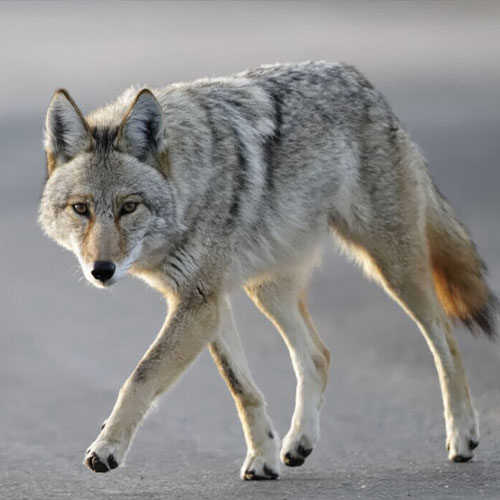
When to Call for Help if You See Coyotes
Coyotes are generally skittish by nature and relocating them through trap and release has actually proven to be ineffective. However, if a coyote appears to be sick or injured, it may result in unpredictable behavior and threaten public safety. If you suspect a coyote is sick or injured, contact 311 immediately and DO NOT interact with the animal.
- Why Killing Coyotes Does Not Work
- Preventing Coyote Conflicts
- Coyote Hazing Guidelines
- What to do about Coyotes
- Changing Coyote Behavior Through Hazing
- Texas Parks & Wildlife Department: Coyotes
- Podtail – Urban Biologist Brett Johnson of the City of Dallas (Coyotes & Bobcats)
- Coyote Safety Kid’s Activity Pages – English
- Coyote Safety Kid’s Activity Pages – Spanish
Coyote Facts
- Coyotes are more commonly seen during the day in the colder months because the animals they hunt are more active during the day due to the cooler nights.
- Coyotes hunt rodents, rabbits, frogs, and fish. They will also eat insects, fruit, grass, and carrion. Coyote attacks on people are extremely rare and most bites that happen nationally are related to humans feeding them.
- Many coyotes in urban environments have become habituated to humans because they associate humans with food sources. Many people intentionally or unintentionally feed them by either leaving out unsecured trash, or pet food outside, or by not limiting feed in bird feeders.
You can help keep your community safe and coyotes away from your home by not providing them with these “free meals” and using “hazing” methods to scare off coyotes if they are sighted. Hazing utilizes tools, your voice, and your body to move an animal out of an undesirable location without touching or injuring the animal. Learn more about “hazing” methods and keeping coyotes away here.
Bobcats
Bobcat Facts
Bobcats are medium-sized wild cats native to Texas and common in urban areas. Bobcat kits may appear similar to domestic cats, but they typically have tufts of hair on the tips of their ears, longer hair on the sides of their heads creating a ruff, a short tail, long legs, and big feet. Adults are generally reclusive and active primarily at night, but kits can be adventurous and roam from their den.
Humans should NEVER interact with, approach, feed, or corner adult or kit bobcats.

When to Call for Help if You See Bobcats
Bobcats may be heard or spotted at a distance during the day or night and may cross through yards, parks, green spaces, or driveways when humans are not present.
Use hazing methods to let the bobcat know that they are not welcome. Make noise, wave your arms, toss objects near (not at) the bobcat, spray them with a hose or otherwise annoy them until they leave.
If the bobcat is not easily scared or appears sick or injured, contact 311 immediately and DO NOT interact with the animal.
If the bobcat is aggressively approaching a person or attacking humans or pets, get to a safe location and call 911.
Raccoons
Raccoons prefer to live near water, brushy areas, and green belts and are also common in Dallas. They are curious and intelligent animals and with their nimble paws, they have a knack for getting into things. Wild raccoons accustomed to being fed by well-intentioned people will generally loose their natural fear of humans and seek to move closer to their food source. Once raccoons take up residence in attics, garages, or outbuildings on your property, the can be destructive and difficult to remove.
Additionally, raccoons are can be carriers of diseases like rabies and distemper which can infect both humans and common household pets, so it’s very important that you do NOT try and interact with, feed, or touch raccoons in the wild.
Raccoon Facts
- Raccoons have excellent night vision and an acute sense of hearing. They are very agile climbers and strong swimmers. They use their nimble fingers to feel stream bottoms for food, to climb trees, and to open containers and garbage cans.
- Raccoons have a diet of fruits and nuts, insects and aquatic invertebrates, fish, small rodents, frogs, bird eggs, carrion, and (especially in Dallas) human garbage.
- Raccoons are almost exclusively nocturnal. Though they prefer woodlands, raccoons can live practically anywhere and have adapted well to human habitats.
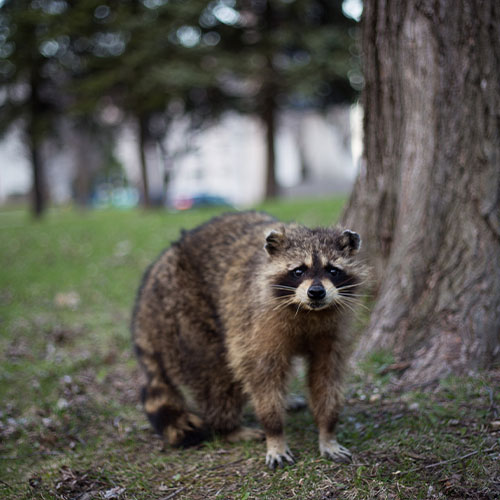
When to Call for Help if You See Raccoons
In general, raccoons don’t pose much of a threat to humans but can be carriers of dangerous diseases that are infectious to both humans and household pets. If you suspect a raccoon is sick or injured, contact 311 immediately and DO NOT interact with the animal.
Opossums
These creatures are beneficial for gardens by eating slugs, bugs and small rodents. They will also pick up garbage and fruit dropped from trees. They also actively seek and kill poisonous snakes – fun fact, they are resistant to snake venom!
Rabies is extremely rare in opossums because of their low body temperature. They also cannot get distemper.
The coma-state defense mechanism is uncontrollable and when an opossum falls over and plays dead, they also excrete a foul-smelling liquid. Most animals will not eat a dead animal that smells rotten.
Opossum Facts
Opossums are North America’s only marsupial! Their babies, known as joeys, are carried in a pouch until fully furred. Opossums can have as many as a dozen or more young, which will be carried on their back day and night for the first 3 – 4 months of their lives.
Opposable thumbs on the hind feet, tail is prehensile, used for balance and to carry nesting materials.
Diet: Carrion, eggs, reptiles, snakes, birds, small mammals, insects, invertebrates, fruit and nuts. Will scavenge garbage and pet food.

Keep Opossums Out of Your Yard
In general, opossums don’t pose much of a threat to humans and can be beneficial to have around. However, if they are not welcome on your property, you can deter them by sealing gaps under sheds, decks and patios and potential entry points in your foundation. Keep pet food indoors and keep bird feeders tidy.
If you suspect an opossum is sick or injured, contact 311 immediately and DO NOT interact with the animal.
Skunks
Skunks are known for the foul odor they spray as a defense mechanism to approaching predators. They are docile, nocturnal creatures and opportunistic eaters. Their diet primarily consists of insects during the spring and summer, then during the cold months when bugs are less accessible, they take advantage of other food sources. They will eat small mammals, eggs, lizards, snakes, fruit and nuts.
Like other wildlife, they are attracted to easy sources of food, so seal those trash cans and clean up fallen fruit and other debris around your yard to avoid skunks taking up residence in your garage or yard.
Skunk Facts
Skunks can live up to 7 years in the wild.
Skunks are nocturnal, but do venture out in the day for food, so there is no cause for concern if you see them in the daytime.
The skunk is one of four wild animals (including the fox, raccoon and bat) considered to be primary carriers of the rabies virus and is, therefore, classified as a rabies vector species. Skunks have also been known to carry leptospirosis. Do not allow pets to interact with skunks.

Keep Skunks Out of Your Yard
In general, skunks don’t pose much of a threat to humans and can be beneficial to have around. However, if they are not welcome on your property, you can deter them by sealing gaps under sheds, decks and patios and potential entry points in your foundation. Keep pet food indoors and keep bird feeders tidy.
If you suspect a skunk is sick or injured, contact 311 immediately and DO NOT interact with the animal.
Armadillos
Although occasionally considered a nuisance by home owners, the armadillo’s habit of digging up lawns is driven by its appetite for grubs, which can also harm lawns.
While you can’t keep your yard totally insect-free, you can use insectisides or go eco-friendly with nematodes! We also recommend picking up fallen fruit and removing other insect attractants.
Armadillo Facts
Armadillos are excellent diggers and cna hold their breath for 6 minutes underwater!
They can jump 3-4 feet vertically when startled, and run up to 30 mph.
Armadillo litters consist of 4 identical quadruplet.
They eat grubs, worms, scorpions, ants, termites, spiders, fruit, eggs, small mammals
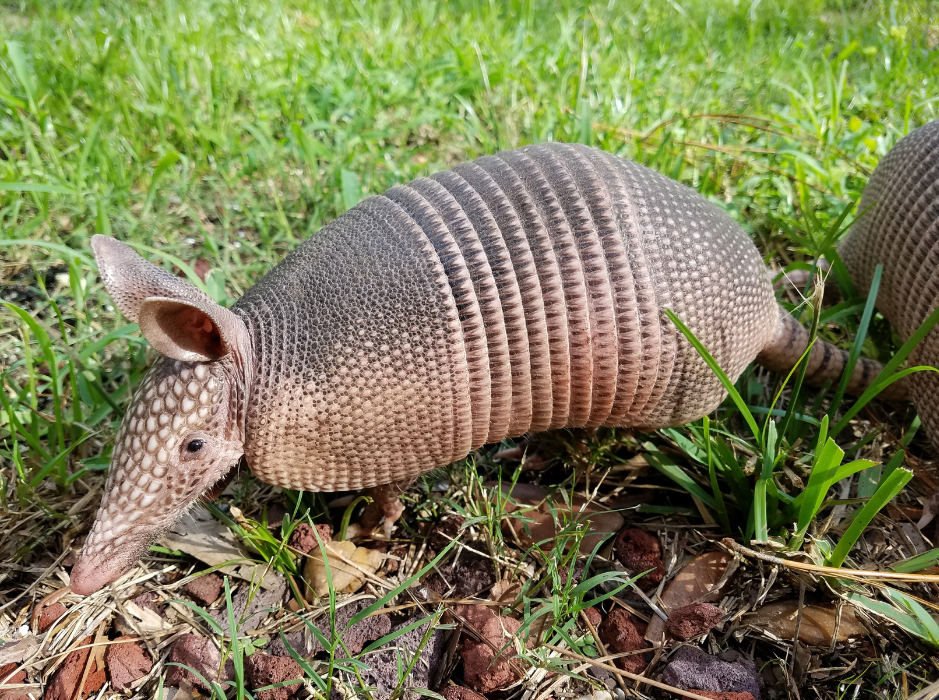
Concerns About Armadillos
Armadillos are one of the few species that carry leprosy, a long-term bacterial infection that can cause permanent nerve damage, so it is important to never touch them.
If you suspect an armadillo is sick or injured, contact 311 immediately and DO NOT interact with the animal.
Snakes
Snakes are cold-blooded and rely on the sunshine and warm weather to stay active. They are generally inactive in the winter.
Most of the snakes in Texas are non-venomous, and easy to identify by their body and facial markings. Bites are harmless and rarely painful, but it’s always a good idea to check in with your doctor after any wildlife encounter. These snakes lay eggs in the spring, which hatch in the summer. These snakes eat live prey or use constriction prior to consumption.
The few venomous snakes found in Dallas can be identified with a combination of attributes being considered collectively; head shape, horizontal markings along the jawline, eye shape, and overall body style. Even venomous snakes are rarely aggressive and usually only bite if cornered, surprised, or threatened.
Snake Facts
Most species of snakes eat small rodents, neonate mammals, birds, eggs, large insects, other snakes, and invertebrates. Diet varies with species and location.
The most common non-venomous snakes in Dallas are the Eastern Rat Snake, Blotched Water Snake, Western Ribbon Snake, and Diamond Back Water Snake.
The most common venomous snakes are various species of rattlesnakes, the Western cottonmouth (also known as water moccasins), the Coral Snake, and three species of Copperheads. Learn more about venomous snakes in Texas.
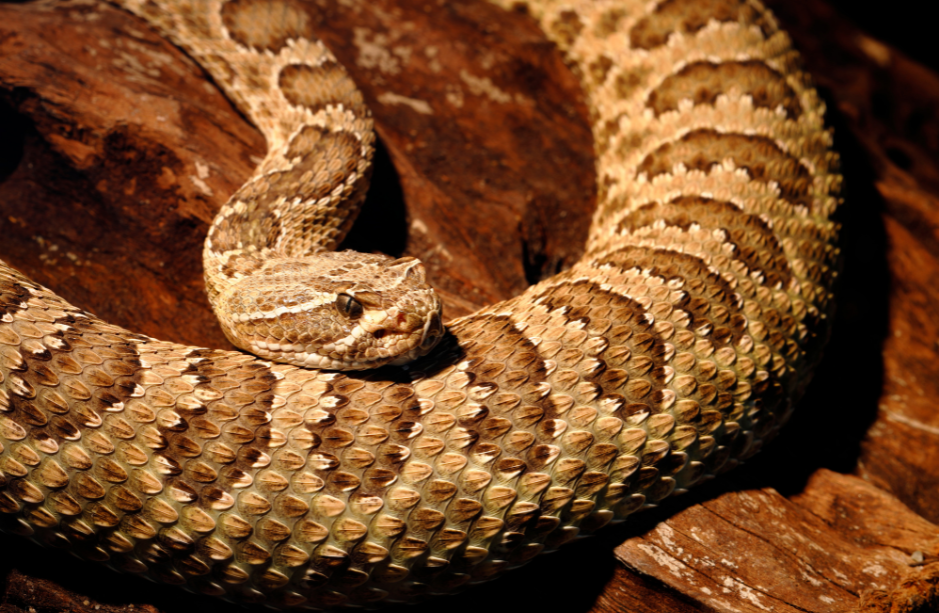
Avoiding Snake Bites
To minimize snake activity in your yard, keep your lawn trimmed, and minimize overgrowth of groundcover. Remove any brush, wood, rock or debris piles from around the residence.
When outdoors, take care when stepping over fallen logs and large boulders. Do not put your hands anywhere you cannot see them.
Never handle a snake that you are unable to identify confidently. A large percentage of bites are incurred by individuals actively trying to kill the snake.
If you have a snake on your property and need assistance, contact 311 immediately and DO NOT interact with the animal.
Bats
Bats play key roles in ecosystems, including in urban areas like Dallas. However, bats can carry transmissible diseases such as rabies. Protect wildlife and yourself by staying away from bats and other wild animals.
Keep Bats Out of Your Home
Examine your home for holes that might allow bats entry. Caulk any openings larger than a dime. Use window screens, chimney caps, and draft-guards beneath doors to attics. Fill electrical and plumbing holes with stainless steel wool, caulk, or other material rated for pest exclusion. Ensure that all doors to the outside close tightly.
If you already have bats in your home, observe where they exit at dusk. Make note of how many there are. Prevent them from coming back by loosely hanging clear plastic sheeting or bird netting over the areas where they exit. This lets any remaining bats crawl out and leave but prevents them from re-entering. Once all the bats are gone, permanently seal the openings.
As you work to bat-proof your home, you may see bats more often as they try to find other exits and entrances. Communicate with your neighbors about bat-proofing efforts. Report incidents of contact between bats and humans or pets to 3-1-1.
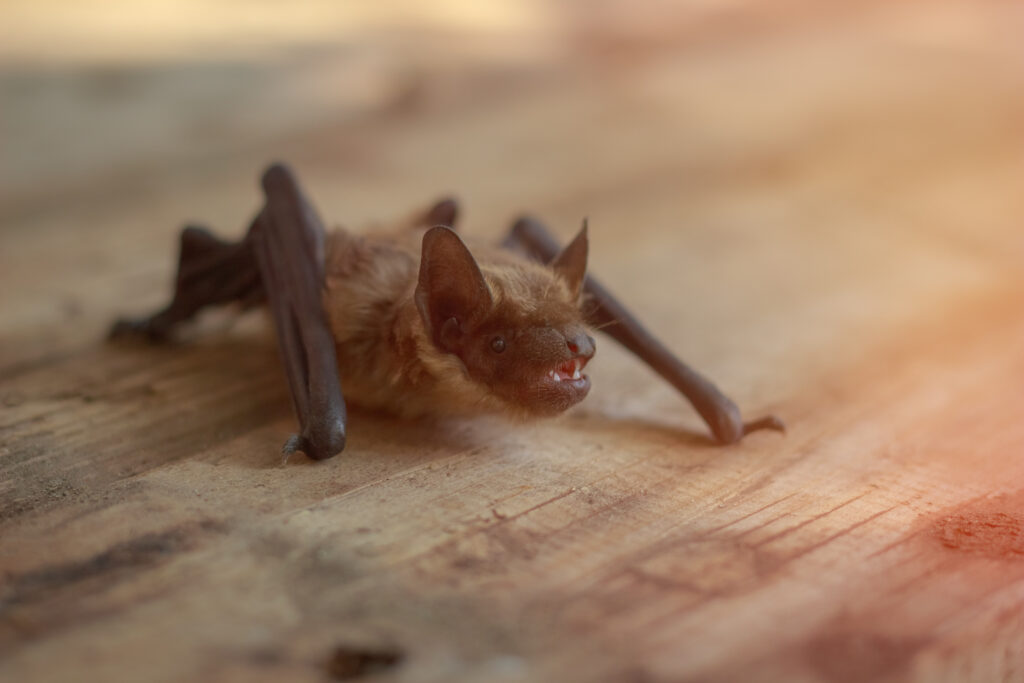
Bat Safety
Bat bites are so small that they often cannot be seen and sometimes not even felt. Anyone who touches a bat should call 3-1-1 and seek medical attention.
Keep kids safe by teaching them not to touch wild animals or strange pets.
If you believe you have been exposed to rabies by being bitten or scratched by an animal or touching a bat, wash your skin and wounds with soap and water, call 311 and seek medical attention immediately.
Beavers
Beavers are considered a keystone species: their presence has extensive effect on the biodiversity of the areas they inhabit.
Beavers prefer to dam streams in shallow valleys, where the flooded area becomes productive wetlands.These cradles of life support biodiversity that rivals tropical rain forests. Almost half of endangered and threatened species in North America rely upon wetlands. Freshwater wetlands have been rated as the world’s most valuable land-based ecosystem.
Beavers reliably and economically maintain wetlands that sponge up floodwaters, alleviate droughts and floods (because their dams keep water on the land longer), lesson erosion, raise the water table and act as the “earth’s kidneys” to purify water. The latter occurs because several feet of silt collect upstream of older beaver dams, and toxics, such as pesticides, are broken down by microbes in the wetlands that beavers create. That means water downstream of dams is cleaner and requires less treatment for human use!

Protect Your Trees From Beavers
If you are concerned about protecting trees from beavers, consider that most cutting occurs within 50 feet of the shore. If you have streams on our near your property in Dallas, you may consider protecting special trees by enclosing the trunks in a wire barrier or painting tree trunks with a sand and paint mixture may prevent beaver gnawing as they dislike the gritty feel of sand in their mouths.
If you have see a beaver that may be injured or ill, contact 311 immediately and DO NOT interact with the animal.
Gray Foxes
Gray Foxes can be found all around the Dallas area. They are very adaptable and do very well in urban and suburban environments. These clever omnivores thrive on small mammals, birds, fruits, and insects.
They are avid climbers and will scale tall trees or structures to escape predation. They are generally fearful of humans.
Keep Foxes From Denning in Your Yard
Secure openings under decks and patios, avoid stacking wood or debris to attract rodents, clean fallen fruit from trees, secure outbuildings.
If you have see a fox that may be injured or ill, contact 311 immediately and DO NOT interact with the animal.

Squirrels
Squirrels are all over the place in Dallas! These critters are an important part of our ecosystem, but they can be pesky when they take over our ceilings and attics.
Keep Squirrels Out of Your Home
Keep flashings, soffits, and eaves in good repair. Chimneys should be capped with wire mesh to prevent accidental and deliberate entry. Trim trees from hanging over rooflines. Clean fallen fruit from under trees and avoid birdfeeders.
If you have see a squirrel that may be injured or ill, contact 311 immediately and DO NOT interact with the animal.

Rabbits
Cottontail rabbits sure are cute, but they can be a nuisance for gardeners and attract predators like coyotes.
Keep Rabbits Out of Your Yard
Rabbits like densely wooded areas and shrubs where they have cover. They may also den under open spaces in residential areas.
To reduce rabbit activity in your yard, keep landscaping maintained. Bushes and shrubs should be trimmed up at least 6-10 inches so as not to provide cover. Use fencing, mesh, or raised beds to protect gardens. Scent deterrents (vinegar, garlic powder, ammonia) can be applied frequently via spray or soaked cottonballs.
Seal off any openings under porches, sheds or decks.
If you have see a rabbit that may be injured or ill, contact 311 immediately and DO NOT interact with the animal.

Mountain Lions
Mountain lions are incredibly rare in this region, it is very unlikely you will encounter one.
Mountain Lion Facts
Mountain lions (aka pumas, cougars, or panthers) weigh 110 – 232 pounds (males) or 79 – 132 pounds (females).
They can leap a distance of 30 feet and can spring 15 feet vertically.
Their populations in south and west Texas are at risk due to poaching and human encroachment onto their habitat.
If you see a mountain lion in Dallas, contact 311 immediately and DO NOT interact with the animal.

If You Encounter a Mountain Lion
DO NOT RUN OR CROUCH. Make yourself big, loud and scary! If they don’t immediately run off, throw sticks, rocks and other debris at the mountain lion. Try not to hit it as we never want to injure wildlife, but make it clear you are capable of defending yourself.
Baby Animals
Do not attempt to feed, water, or bathe an orphaned animal of any species. Caring for any species of indigenous wildlife requires a license from the state and is best left to professionals with extensive training and experience. Each animal requires formulas and feeding techniques designed specifically for their species and stage of development. More importantly, body temperature, injuries, and overall condition needs to be assessed by a professional, as feeding a cold, injured, or compromised animal can result in its death relatively quickly.
CRITICAL: Any animal found with visible injuries such as punctures, cuts, broken limbs, or an animal that has ants, flies, or fly eggs on or around it is considered critical and needs immediate medical attention. Please contain the animal safely with gloves and contact 311 for assistance as soon as possible.
Orphaned Raccoons, Squirrels, Skunks or Foxes
Mothers of these species will often return for their young, unless they have been forcibly removed from the area and relocated or injured/killed while out scavenging or hunting. If the baby animal is in a safe place protected from the elements (hidden under bushes, in the shade near a tree, under a deck) it can be left and monitored. If the animal is in an open area or in direct sunlight, the animal can be gathered up using gloves and towel and placed in a box or laundry basket lined with soft cloth. The animal can then be placed outside in a protected area near the location where it was found and allow 12-24 hours for the mother to return and retrieve. If the orphan is not retrieved, contact 311 or your local wildlife rehabilitator for assistance.
Orphaned Oppossums
Joeys that fall off their mother are rarely retrieved, as she carries so many she is usually unaware that one has been left behind. Opossums found with no hair and their eyes still closed are considered critical; using gloves gather the animal with a soft cloth and contain, while keeping warm with a heating pad on low for transport or pickup. Joeys with their eyes open still need assistance, and can be contained the same way. Joeys prefer to be wrapped in cloth, as they prefer the security of a pouch. Contact 311 or your local wildlife rehabilitator for assistance.
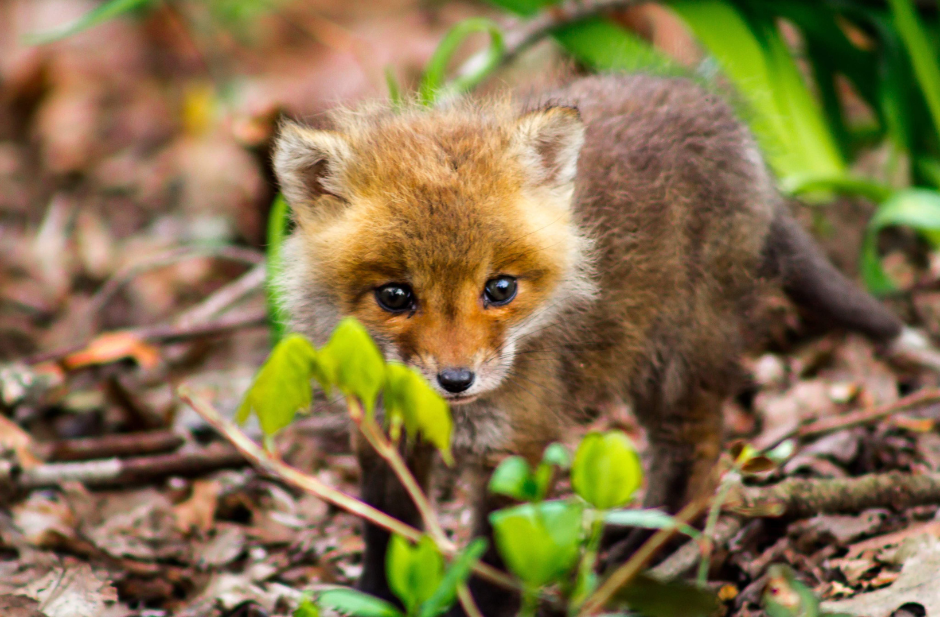
Orphaned Bats
Baby bats will sometimes fall off their mothers during flight. Mothers are rarely able to retrieve their young if they have fallen. Using gloves and a soft cloth, place the baby bat in a small container with a lid (not airtight) and contact 311 or a local wildlife rehabilitator as soon as possible.
Orphaned Cottontail Rabbits
This species makes their nest out in the open, in a very shallow hole covered with grasses and fur. The vast majority of rabbit nests found are not abandoned and can be monitored for mother’s activity as follows:
Place string or thin strips of fabric over the nesting site in a tic-tac-toe pattern and monitor overnight. If the pattern is not disturbed for over 24 hours, it is likely that the mother is unable to return, and the babies and their nesting material can be gathered into a small container or box and kept warm while arranging transport. Call 311 or your local wildlife rehabilitator for assistance.
If a nest has been disturbed by a dog: after ensuring the babies have no visible injuries, place them back in the nest and cover with a small amount of grass of fur. Place a laundry basket over the nest or a small fence/gates around the area during the day to prohibit domestic animals from accessing, then remove the basket or open the gate in the evenings and overnight for the mother to come and care for the babies. Contact your local wildlife rehabilitator for more assistance and advice on keeping the animals safe until they are able to leave the area on their own, which is usually within a few weeks.
